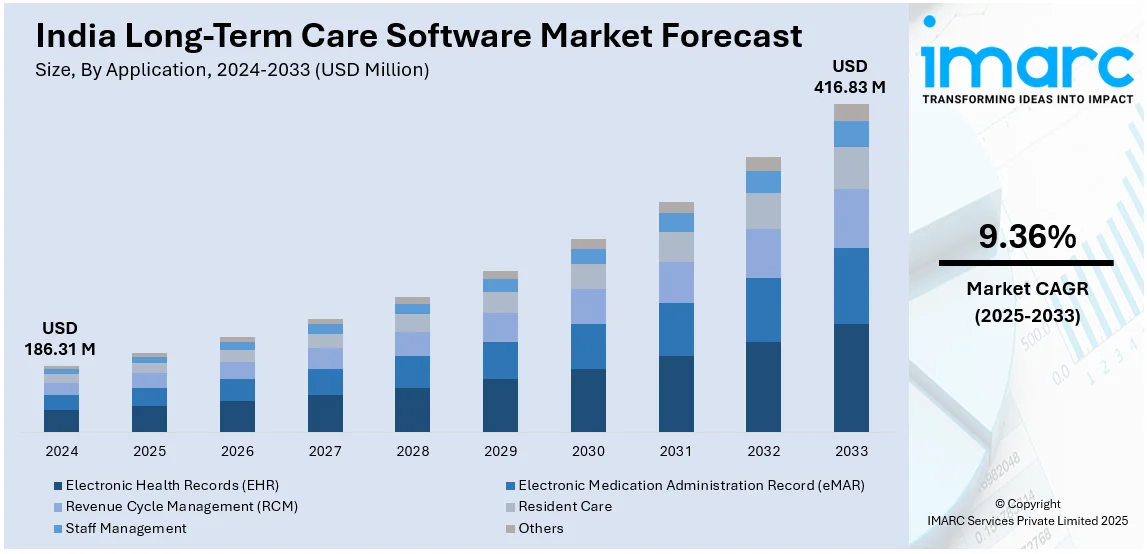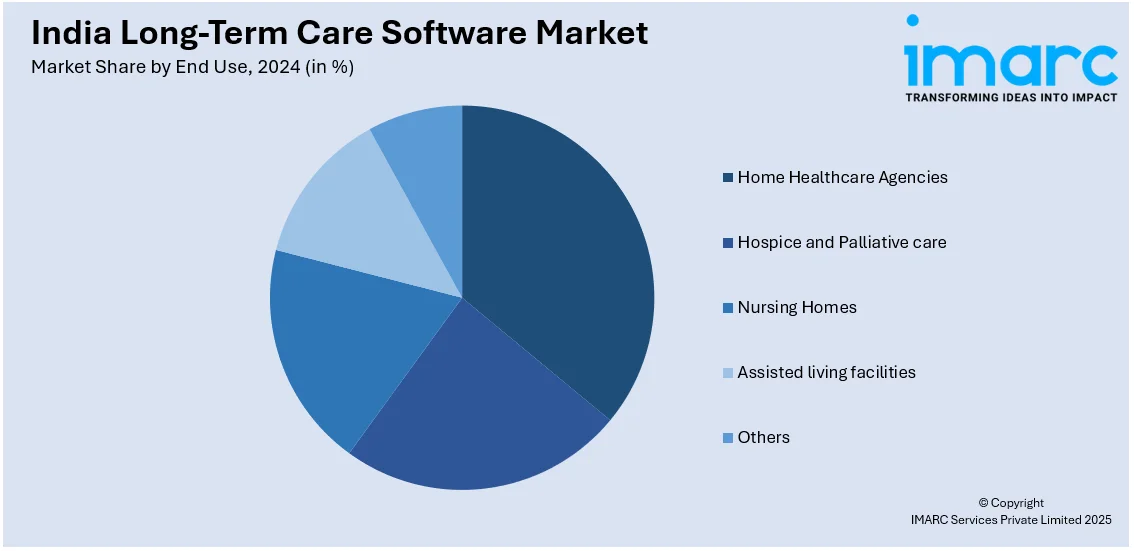
India Long-Term Care Software Market Size, Share, Trends and Forecast by Application, Mode of Delivery, End Use, and Region, 2025-2033
India Long-Term Care Software Market Size and Share:
The India long-term care software market size reached USD 186.31 Million in 2024. Looking forward, IMARC Group expects the market to reach USD 416.83 Million by 2033, exhibiting a growth rate (CAGR) of 9.36% during 2025-2033. The India long-term care software market share is expanding, driven by the increasing prevalence of chronic conditions that require continuous monitoring and tracking, medication management, and personalized treatment plans, along with the rising adoption of government programs, encouraging healthcare providers to employ digital platforms.
|
Report Attribute
|
Key Statistics
|
|---|---|
|
Base Year
|
2024
|
|
Forecast Years
|
2025-2033
|
|
Historical Years
|
2019-2024
|
| Market Size in 2024 | USD 186.31 Million |
| Market Forecast in 2033 | USD 416.83 Million |
| Market Growth Rate (2025-2033) | 9.36% |
India Long-Term Care Software Market Trends:
Growing incidence of chronic diseases
The rising prevalence of chronic diseases is offering a favorable India long-term care software market outlook. According to industry reports, as of February 2024, diseases of the respiratory system represented the largest health issue in India, accounting for 15.3% of all prescriptions for patients with illnesses in the country. Conditions, such as diabetes, cardiovascular diseases, arthritis, and respiratory disorders require continuous monitoring, medication management, and personalized treatment plans. Long-term care software helps healthcare providers to track patient progress, manage medical records, and schedule timely interventions, improving overall care quality. As chronic conditions often demand frequent doctor visits and ongoing support, this software streamlines communication between caregivers, specialists, and family members, ensuring better coordination. It also offers features like automated reminders for medications, follow-up appointments, and therapy sessions, aiding patients in adhering to treatment plans. With India witnessing a steady rise in lifestyle-related illnesses, hospitals, nursing homes, and home care services are adopting long-term care software to manage complex cases efficiently. The software’s ability to generate reports, track vitals, and provide real-time data enhances decision-making for healthcare providers.

To get more information on this market, Request Sample
Increasing execution of government initiatives
The rising implementation of government initiatives for healthcare digitization is impelling the India long-term care software market growth. The Indian Union Budget for 2024-25 focused on enhancing the healthcare sector by expanding digital infrastructure and adjusting health spending to INR 89,287 Crores (USD 10.70 Billion), with the goal of improving accessibility and innovations in healthcare offerings. Government programs aim to create a unified digital health ecosystem, encouraging healthcare providers to adopt electronic health records (EHR) and digital platforms. This push for digitization enables long-term care facilities to efficiently manage patient data, track medical histories, and streamline communication between caregivers, doctors, and family members. By integrating digital tools, healthcare providers can enhance care coordination, medication tracking, and treatment planning for patients requiring extended care. Additionally, government-supported incentives and funding motivate hospitals, nursing homes, and home care services to wager on modern software solutions. Digital platforms also enhance remote monitoring, teleconsultations, and virtual health services, making long-term care more accessible to patients in rural and underserved areas. As healthcare digitization gains momentum, the demand for reliable long-term care software is increasing, refining care quality, operational efficiency, and patient outcomes across India.
India Long-Term Care Software Market Segmentation:
IMARC Group provides an analysis of the key trends in each segment of the market, along with forecasts at the regional level for 2025-2033. Our report has categorized the market based on application, mode of delivery, and end use.
Application Insights:
- Electronic Health Records (EHR)
- Electronic Medication Administration Record (eMAR)
- Revenue Cycle Management (RCM)
- Resident Care
- Staff Management
- Others
The report has provided a detailed breakup and analysis of the market based on the applications. This includes electronic health records (EHR), electronic medication administration record (eMAR), revenue cycle management (RCM), resident care, staff management, and others.
Mode of Delivery Insights:
- Cloud based
- Web based
- On premise
A detailed breakup and analysis of the market based on the modes of delivery have also been provided in the report. This includes cloud based, web based, and on premise.
End Use Insights:

- Home Healthcare Agencies
- Hospice and Palliative care
- Nursing Homes
- Assisted living facilities
- Others
The report has provided a detailed breakup and analysis of the market based on the end uses. This includes home healthcare agencies, hospice and palliative care, nursing homes, assisted living facilities, and others.
Regional Insights:
- North India
- South India
- East India
- West India
The report has also provided a comprehensive analysis of all the major regional markets, which include North India, South India, East India, and West India.
Competitive Landscape:
The market research report has also provided a comprehensive analysis of the competitive landscape. Competitive analysis such as market structure, key player positioning, top winning strategies, competitive dashboard, and company evaluation quadrant has been covered in the report. Also, detailed profiles of all major companies have been provided.
India Long-Term Care Software Market News:
- In September 2024, SA Technologies, based in San Jose, California, unveiled its advanced Global Capability Center (GCC) in Pune, India. This facility was tailored for Tendable, offering a strong and scalable service delivery model from one of the world’s fastest-growing technology centers. The company's goal was to develop the simplest and most dependable quality improvement and assurance instruments that provided the best insights throughout various clinical settings, such as clinics, wards, operating rooms, long-term care facilities, homes, and community services.
- In June 2023, TatvaCare, specializing in advanced technology in healthcare, developed an innovative digital therapeutics platform, 'MyTatva', in India. The product aimed to deliver an enhanced solution for patients suffering from chronic diseases that require long-term care. It integrated customized care plans and counseling services to boost adherence. Digital therapeutics formed a segment of digital health services that provided therapeutic interventions directly to patients through evidence-based and clinically assessed software for managing diseases.
India Long-Term Care Software Market Report Coverage:
| Report Features | Details |
|---|---|
| Base Year of the Analysis | 2024 |
| Historical Period | 2019-2024 |
| Forecast Period | 2025-2033 |
| Units | Million USD |
| Scope of the Report |
Exploration of Historical Trends and Market Outlook, Industry Catalysts and Challenges, Segment-Wise Historical and Future Market Assessment:
|
| Applications Covered | Electronic Health Records (EHR), Electronic Medication Administration Record (eMAR), Revenue Cycle Management (RCM), Resident Care, Staff Management, Others |
| Modes of Delivery Covered | Cloud based, Web based, On premise |
| End Uses Covered | Home Healthcare Agencies, Hospice and Palliative care, Nursing Homes, Assisted living facilities, Others |
| Regions Covered | North India, South India, East India, West India |
| Customization Scope | 10% Free Customization |
| Post-Sale Analyst Support | 10-12 Weeks |
| Delivery Format | PDF and Excel through Email (We can also provide the editable version of the report in PPT/Word format on special request) |
Key Benefits for Stakeholders:
- IMARC’s industry report offers a comprehensive quantitative analysis of various market segments, historical and current market trends, market forecasts, and dynamics of the India long-term care software market from 2019-2033.
- The research report provides the latest information on the market drivers, challenges, and opportunities in the India long-term care software market.
- Porter's five forces analysis assist stakeholders in assessing the impact of new entrants, competitive rivalry, supplier power, buyer power, and the threat of substitution. It helps stakeholders to analyze the level of competition within the India long-term care software industry and its attractiveness.
- Competitive landscape allows stakeholders to understand their competitive environment and provides an insight into the current positions of key players in the market.
Key Questions Answered in This Report
The India long-term care software market reached a value of USD 186.31 Million in 2024.
The market is projected to reach USD 416.83 Million by 2033, growing at a CAGR of 9.36% during 2025-2033.
Market growth is driven by the rising geriatric population, increasing demand for efficient healthcare management in long-term care facilities, and the growing burden of chronic diseases. The shift towards digital healthcare, government initiatives promoting healthcare IT infrastructure, and the need for integrated and interoperable solutions are further propelling adoption. Additionally, advancements in cloud-based platforms, electronic health records (EHR), and analytics-driven decision-making are enhancing operational efficiency, thus boosting market potential across public and private care facilities.
Need more help?
- Speak to our experienced analysts for insights on the current market scenarios.
- Include additional segments and countries to customize the report as per your requirement.
- Gain an unparalleled competitive advantage in your domain by understanding how to utilize the report and positively impacting your operations and revenue.
- For further assistance, please connect with our analysts.
 Request Customization
Request Customization
 Speak to an Analyst
Speak to an Analyst
 Request Brochure
Request Brochure
 Inquire Before Buying
Inquire Before Buying




.webp)




.webp)












